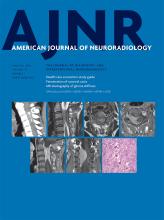Index by author
Bae, S.
- Adult BrainYou have accessPrediction of IDH1-Mutation and 1p/19q-Codeletion Status Using Preoperative MR Imaging Phenotypes in Lower Grade GliomasY.W. Park, K. Han, S.S. Ahn, S. Bae, Y.S. Choi, J.H. Chang, S.H. Kim, S.-G. Kang and S.-K. LeeAmerican Journal of Neuroradiology January 2018, 39 (1) 37-42; DOI: https://doi.org/10.3174/ajnr.A5421
Bae, Y.J.
- Head and Neck ImagingYou have accessDiffusion-Weighted Imaging of the Head and Neck: Influence of Fat-Suppression Technique and Multishot 2D Navigated Interleaved AcquisitionsY.J. Bae, B.S. Choi, H.-K. Jeong, L. Sunwoo, C. Jung and J.H. KimAmerican Journal of Neuroradiology January 2018, 39 (1) 145-150; DOI: https://doi.org/10.3174/ajnr.A5426
Baek, J.H.
- Head and Neck ImagingYou have accessEffect of an Arm Traction Device on Image Quality and Radiation Exposure during Neck CT: A Prospective StudyY.J. Choi, J.H. Lee, D.H. Yoon, H.J. Kim, K.J. Seo, K.-H. Do and J.H. BaekAmerican Journal of Neuroradiology January 2018, 39 (1) 151-155; DOI: https://doi.org/10.3174/ajnr.A5418
Barber, P.A.
- InterventionalOpen AccessTime for a Time Window Extension: Insights from Late Presenters in the ESCAPE TrialJ.W. Evans, B.R. Graham, P. Pordeli, F.S. Al-Ajlan, R. Willinsky, W.J. Montanera, J.L. Rempel, A. Shuaib, P. Brennan, D. Williams, D. Roy, A.Y. Poppe, T.G. Jovin, T. Devlin, B.W. Baxter, T. Krings, F.L. Silver, D.F. Frei, C. Fanale, D. Tampieri, J. Teitelbaum, D. Iancu, J. Shankar, P.A. Barber, A.M. Demchuk, M. Goyal, M.D. Hill and B.K. Menon for the ESCAPE Trial InvestigatorsAmerican Journal of Neuroradiology January 2018, 39 (1) 102-106; DOI: https://doi.org/10.3174/ajnr.A5462
Barkan, G.A.
- Head and Neck ImagingYou have accessPatterns of Sonographically Detectable Echogenic Foci in Pediatric Thyroid Carcinoma with Corresponding Histopathology: An Observational StudyI. Erdem Toslak, B. Martin, G.A. Barkan, A.I. Kılıç and J.E. Lim-DunhamAmerican Journal of Neuroradiology January 2018, 39 (1) 156-161; DOI: https://doi.org/10.3174/ajnr.A5419
Baron, J.-C.
- FELLOWS' JOURNAL CLUBAdult BrainYou have accessDo Fluid-Attenuated Inversion Recovery Vascular Hyperintensities Represent Good Collaterals before Reperfusion Therapy?E. Mahdjoub, G. Turc, L. Legrand, J. Benzakoun, M. Edjlali, P. Seners, S. Charron, W. Ben Hassen, O. Naggara, J.-F. Meder, J.-L. Mas, J.-C. Baron and C. OppenheimAmerican Journal of Neuroradiology January 2018, 39 (1) 77-83; DOI: https://doi.org/10.3174/ajnr.A5431
The authors evaluated 244 consecutive patients eligible for reperfusion therapy with MCA stroke and pretreatment MR imaging with both FLAIR and PWI. The FLAIR vascular hyperintensity score was based on ASPECTS, ranging from 0 (no FLAIR vascular hyperintensity) to 7 (FLAIR vascular hyperintensities abutting all ASPECTS cortical areas). The hypoperfusion intensity ratio was defined as the ratio of the time-to-maximum >10-second over time-to-maximum >6-second lesion volumes. The FLAIR vascular hyperintensities were more extensive in patients with good collaterals than those with poor collaterals. The FLAIR vascular hyperintensity score was independently associated with good collaterals. They conclude that the ASPECTS assessment of FLAIR vascular hyperintensities could be used to rapidly identify patients more likely to benefit from reperfusion therapy.
Bassareo, P.P.
- Extracranial VascularYou have accessCT Attenuation Analysis of Carotid Intraplaque HemorrhageL. Saba, M. Francone, P.P. Bassareo, L. Lai, R. Sanfilippo, R. Montisci, J.S. Suri, C.N. De Cecco and G. FaaAmerican Journal of Neuroradiology January 2018, 39 (1) 131-137; DOI: https://doi.org/10.3174/ajnr.A5461
Baxter, B.W.
- InterventionalOpen AccessTime for a Time Window Extension: Insights from Late Presenters in the ESCAPE TrialJ.W. Evans, B.R. Graham, P. Pordeli, F.S. Al-Ajlan, R. Willinsky, W.J. Montanera, J.L. Rempel, A. Shuaib, P. Brennan, D. Williams, D. Roy, A.Y. Poppe, T.G. Jovin, T. Devlin, B.W. Baxter, T. Krings, F.L. Silver, D.F. Frei, C. Fanale, D. Tampieri, J. Teitelbaum, D. Iancu, J. Shankar, P.A. Barber, A.M. Demchuk, M. Goyal, M.D. Hill and B.K. Menon for the ESCAPE Trial InvestigatorsAmerican Journal of Neuroradiology January 2018, 39 (1) 102-106; DOI: https://doi.org/10.3174/ajnr.A5462
Belov, P.
- Extracranial VascularOpen AccessLower Arterial Cross-Sectional Area of Carotid and Vertebral Arteries and Higher Frequency of Secondary Neck Vessels Are Associated with Multiple SclerosisP. Belov, D. Jakimovski, J. Krawiecki, C. Magnano, J. Hagemeier, L. Pelizzari, B. Weinstock-Guttman and R. ZivadinovAmerican Journal of Neuroradiology January 2018, 39 (1) 123-130; DOI: https://doi.org/10.3174/ajnr.A5469
Ben Hassen, W.
- FELLOWS' JOURNAL CLUBAdult BrainYou have accessDo Fluid-Attenuated Inversion Recovery Vascular Hyperintensities Represent Good Collaterals before Reperfusion Therapy?E. Mahdjoub, G. Turc, L. Legrand, J. Benzakoun, M. Edjlali, P. Seners, S. Charron, W. Ben Hassen, O. Naggara, J.-F. Meder, J.-L. Mas, J.-C. Baron and C. OppenheimAmerican Journal of Neuroradiology January 2018, 39 (1) 77-83; DOI: https://doi.org/10.3174/ajnr.A5431
The authors evaluated 244 consecutive patients eligible for reperfusion therapy with MCA stroke and pretreatment MR imaging with both FLAIR and PWI. The FLAIR vascular hyperintensity score was based on ASPECTS, ranging from 0 (no FLAIR vascular hyperintensity) to 7 (FLAIR vascular hyperintensities abutting all ASPECTS cortical areas). The hypoperfusion intensity ratio was defined as the ratio of the time-to-maximum >10-second over time-to-maximum >6-second lesion volumes. The FLAIR vascular hyperintensities were more extensive in patients with good collaterals than those with poor collaterals. The FLAIR vascular hyperintensity score was independently associated with good collaterals. They conclude that the ASPECTS assessment of FLAIR vascular hyperintensities could be used to rapidly identify patients more likely to benefit from reperfusion therapy.








